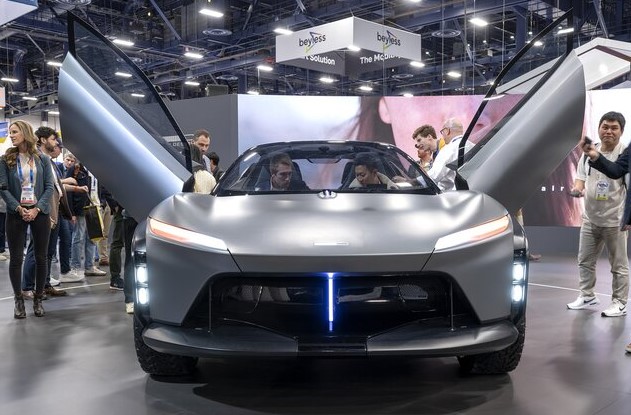4 Cool Electric Cars and Automotive Technologies at CES 2025
Introduction: The Importance of CES in the Automotive Industry
CES (Consumer Electronics Show) is one of the most prominent events in the world for showcasing innovations in consumer technology. While traditionally focused on electronics, CES has become an important platform for the automotive industry to introduce new concepts, electric vehicles, and cutting-edge automotive technologies. As the automotive world continues to embrace electrification, automation, and advanced connectivity, CES 2025 is expected to showcase some of the most futuristic and game-changing vehicles and technologies that will shape the future of transportation.
In this article, we will explore four of the coolest electric cars and automotive technologies unveiled at CES 2025. These vehicles and innovations highlight the continued evolution of electric mobility, autonomous driving, connected car systems, and sustainable transportation solutions. With advancements in design, performance, and user experience, these products will set the tone for the future of driving in the next decade.
1. Hyundai Mobis Holographic Dashboard in the Kia EV9
One of the most exciting automotive innovations presented at CES 2025 is Hyundai Mobis’ holographic dashboard, integrated in the Kia EV9, an all-electric SUV. This innovative technology takes in-car infotainment and user experience to the next level by utilizing holographic display technology to present information in three-dimensional space.
Key Features:
• Holographic Display: The holographic dashboard allows the driver and passengers to view important vehicle data, entertainment options, and navigation details in 3D, without the need for 3D glasses. The display will be floating in mid-air, offering a more immersive and futuristic interface.
• Intuitive Interface: The dashboard will use advanced AI to predict what information the driver may need based on context. For example, if the vehicle is approaching a turn, the system might highlight the upcoming navigation information or nearby points of interest.
• Enhanced Safety: The holographic display can be used to provide real-time safety information, such as alerts about nearby objects or pedestrians, improving situational awareness and reducing the likelihood of accidents.
• Customizable Experience: Users can personalize the holographic dashboard to display relevant information in the most convenient format. This includes setting preferences for music, navigation, and climate control, all in a visually appealing 3D interface.
Impact on the Automotive Industry:
This holographic display is an example of how advanced technology can enhance the driver experience while improving safety and efficiency. It aligns with the growing trend of integrating augmented reality (AR) and virtual reality (VR) into vehicles, offering more immersive ways to interact with the car’s systems.
2. BYD DiPilot Autonomous Driving Technology
At CES 2025, BYD (Build Your Dreams), one of the largest electric vehicle manufacturers in China, unveiled its advanced autonomous driving technology known as DiPilot. DiPilot is an autonomous driving system that leverages AI, machine learning, and an array of sensors to provide full autonomy and enhance the driving experience.
Key Features:
• Level 4 Autonomous Driving: By 2025, BYD’s DiPilot technology aims to achieve Level 4 autonomy, meaning the vehicle can operate independently without human intervention in specific environments (e.g., highways, urban areas with mapped routes). The driver will not need to take over control of the vehicle in these conditions.
• AI-Powered Decision Making: DiPilot uses advanced AI algorithms to process data from a combination of sensors, including cameras, lidar, radar, and ultrasonic sensors. This allows the system to understand the car’s surroundings in real time, make decisions, and adapt to different traffic scenarios.
• Adaptive Learning: The system learns from its environment and experiences, becoming more accurate and efficient over time. DiPilot will improve its ability to navigate new situations by continuously collecting and analyzing data from thousands of other vehicles using the same system.
• Safety Features: DiPilot is designed to improve safety by eliminating human errors, which account for a large portion of traffic accidents. The system can react faster than human drivers to avoid collisions and maintain safe distances between vehicles.
Impact on the Automotive Industry:
DiPilot is a step forward in making autonomous driving technology accessible to the mass market. By integrating this system into their vehicles, BYD is positioning itself as a leader in the autonomous vehicle space. The technology also points to a future where human drivers may be phased out entirely in specific driving scenarios, paving the way for more advanced forms of transportation.
3. Sony Mobility Vision-S 02 Electric SUV
Sony, traditionally known for its consumer electronics, has ventured further into the automotive world with its Vision-S 02 concept electric SUV, which was showcased at CES 2025. This electric SUV is an evolution of the Vision-S 01, a sedan that Sony first unveiled in 2020. The Vision-S 02 represents the company’s vision of a future where in-car entertainment, connectivity, and cutting-edge technology come together to offer a holistic user experience.
Key Features:
• Advanced In-Car Entertainment: One of the standout features of the Vision-S 02 is its integration of Sony’s entertainment technologies. The SUV is equipped with high-definition screens that provide passengers with immersive content, including movies, music, and gaming options.
• 360 Reality Audio: Sony’s proprietary 360 Reality Audio system will deliver spatial sound, creating an audio experience that envelops passengers in high-quality, three-dimensional sound. This system will enhance the overall ride experience and is particularly appealing to those who value entertainment while traveling.
• Interior Design and Comfort: The Vision-S 02 features a sleek, modern interior with futuristic materials and flexible seating arrangements. The cabin can be transformed into a relaxing space where passengers can enjoy entertainment or work during long trips.
• AI-Driven Assistance: The SUV is equipped with advanced AI systems that learn from the driver’s preferences and behavior. The car can adjust settings such as climate control, seat positions, and entertainment options based on individual preferences.
Impact on the Automotive Industry:
Sony’s Vision-S 02 marks a significant step toward integrating consumer electronics with electric vehicles. Sony is leveraging its expertise in entertainment and media to offer a differentiated user experience, making the driving or riding experience more enjoyable. As in-car entertainment becomes a major selling point, other automakers will likely follow Sony’s lead by integrating more advanced technology into their vehicles.
4. Fisker Ocean Electric SUV with Advanced Sustainability Features
Fisker, a brand known for its focus on sustainable and innovative electric vehicles, made waves at CES 2025 with its Ocean electric SUV. This vehicle combines eco-friendly materials, cutting-edge technology, and impressive performance, making it an attractive option for consumers who prioritize sustainability.
Key Features:
• Sustainable Materials: The Fisker Ocean is designed with sustainability in mind. The car uses recycled materials throughout its construction, including vegan leather, plastic waste, and sustainable textiles. The dashboard and interior elements are made from bio-based materials that minimize the car’s environmental impact.
• Solar Roof Technology: The Fisker Ocean comes equipped with a solar roof, which can generate energy to charge the vehicle’s battery, contributing to an extended driving range. This technology will be particularly useful for customers who live in areas with abundant sunlight.
• Advanced Battery Tech: Fisker has partnered with advanced battery manufacturers to create a lightweight and efficient battery system that offers a range of up to 350 miles on a single charge. The vehicle also supports fast charging, allowing drivers to replenish the battery quickly.
• Fisker Intelligent Sensing: The SUV features a suite of advanced driver-assist systems, including a 360-degree camera, lidar, and radar, all working together to enhance safety and enable semi-autonomous driving capabilities.
Impact on the Automotive Industry:
Fisker’s Ocean SUV is a testament to the growing importance of sustainability in the electric vehicle market. As consumers become more environmentally conscious, the demand for vehicles that are both electric and made from sustainable materials will continue to rise. Fisker’s commitment to eco-friendly practices and cutting-edge technology makes it a strong player in the EV space.
Conclusion: The Future of Electric Vehicles and Automotive Technology at CES 2025
CES 2025 has proven that the future of the automotive industry is firmly rooted in electric vehicles, autonomous driving, and connected technology. The four vehicles showcased—Hyundai Mobis’ holographic dashboard in the Kia EV9, BYD’s DiPilot autonomous driving technology, Sony’s Vision-S 02 electric SUV, and Fisker’s Ocean electric SUV—are a glimpse into the future of transportation. These innovations highlight the diverse ways in which the automotive industry is embracing technology to create safer, more enjoyable, and more sustainable driving experiences.
As we move forward, CES will continue to be a key platform for showcasing the latest automotive technologies, driving the evolution of the electric vehicle market and transforming the way we interact with our cars. From fully autonomous driving to the integration of entertainment and sustainability, the vehicles of tomorrow will be smarter, more efficient, and more connected than ever before.



